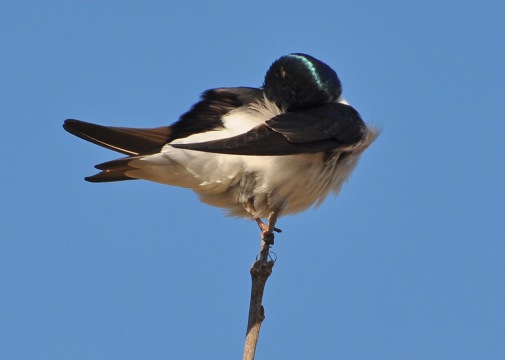Countless species of woody plants, native and exotic, invade abandoned farmland after a few short years. Dogwoods, viburnums, honeysuckles, buckthorn, multiflora rose and white ash are prominent colonizers in this area. In order to sustain a variety of wildlife species on these sites, some sort of habitat management is inevitable. The maintenance of large herbaceous openings with an annual mowing (brush-hogging) that subordinates and/or eliminates woody vegetation is one example. With the addition of nest boxes, such habitats will attract and support tree swallows, blue birds, house wrens and other cavity nesting birds.
The first migratory bird species to arrive and claim nest boxes at my location is the tree swallow (in more suitable habitat it might be the bluebird). I watch several pairs of tree swallows every spring as they feed on the wing, court, fight, build nests, defend nests and raise young. Every year I think I have enough swallow pics and will leave the camera at home while I’m working in the field. And every year I take more pictures! Love these graceful little bug-eating machines!!!
Photos by NB Hunter. © All Rights Reserved.





These guys are hard to get good photos of but you managed to get some great ones. My favorite is the one where he/she is tucking the head under the wing.
I love the swooping graceful flight of the tree swallow as the feed…I call them ‘sky dancers.’ I am so glad you take more photos each year…These are really nice.
Ha, I do the same thing. I have lots of Swallow photos, but they MAKE me take more. They are very entertaining. Oh, and so shiny.
That last shot is a winner, though I truly admired all until I arrived at that one!
I am of kindred spirit, Nick… Swallows are one of my favorite bird species. I love seeing them return here in the spring, and am so sad when the sky goes empty of their grace in the fall. When it comes to photos of swallows, one can never have enough!!!
Really enjoyed this post ❤
Jane
Amazing photos, Nick! Lovely capture of the iridescence on their plumage.
Thanks Jo! I do feel very fortunate to have the opportunity to monitor lots of nest boxes and capture the life cycles of cavity nesting birds.